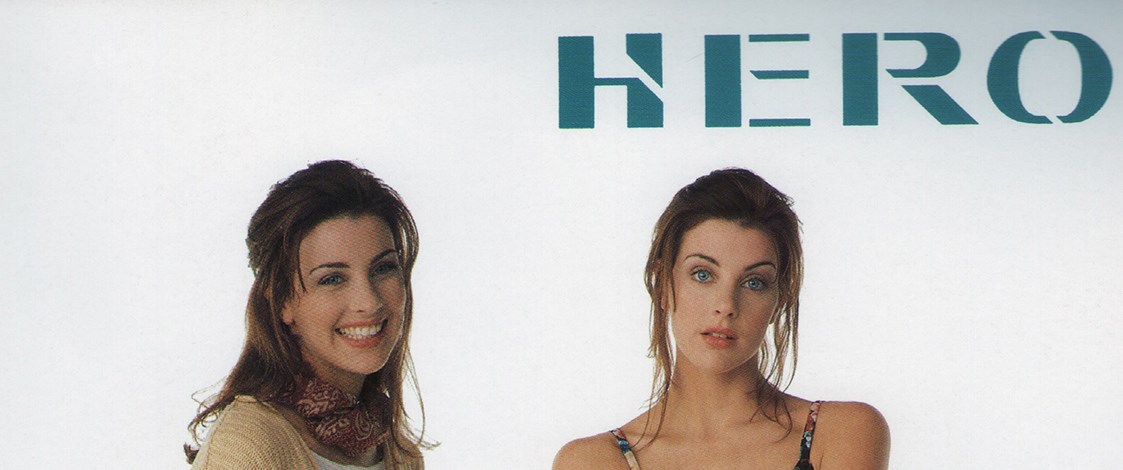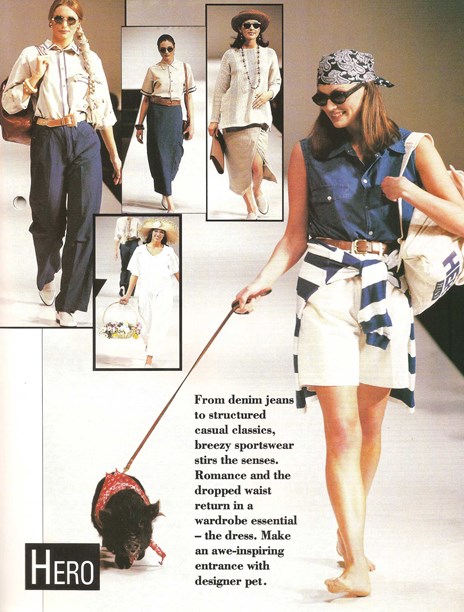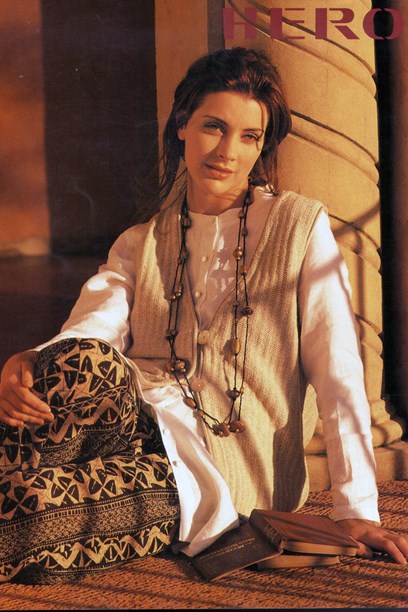Stories
Hero
1987-

What do you do when your potential licensor turns out to be less than reasonable? You start your own rival brand - as did Ian Webster and Neil Brabant in 1987 with Hero.
Both born in Auckland and qualified in advertising/marketing and accountancy respectively, the pair met at the French Pant Company where Ian was assistant general manager and Brabant was the accountant. Owned by John Carter and Milan Vega, the French Pant Company held the franchise for the Sasson jeans label - the first international designer jean label to be introduced into New Zealand. Sasson quickly carved out a strong position in the new and growing, branded lifestyle garment market. Ground breaking marketing initiatives like the brand’s 'retail customer only' in-store parades were a first for this country.

Neil Brabant and Ian Webster., 1989. Image © Hero.
These were heady times in business and fashion was no exception, for example: the French Pant Company would confidently commit to 25,000 meters of six-wale (number of cords per inch) corduroy before they had sold a single garment. When Jack Cooper was appointed as general manager, Ian became the design and marketing manager further advancing the company’s success such that a few years later it joined the portfolio of the publicly listed corporation, Apparel Holdings.
It was Jack who, some time after leaving Apparel Holdings, signalled that the Guess label might be available for New Zealand. Ian travelled on his own and Neil’s behalf to the United States to meet with the owners but discovered that their demands for forward royalties and minimum sales were unreasonable in the New Zealand market. They then decided the best option was to create a new brand to compete with both Guess and Sasson in the New Zealand and Australian markets. "Neil and I figured if we could take half the Sasson business we’d be fine," Ian says. To ensure they had enough working capital to fund the venture the pair teamed up with Susie and Charles Macindoe (owner of Snow Rainger Textiles) each owning one third of the company.
Its name, Hero, essentially plucked from a book of brand names, targeted 35-60 year old women and presented itself as a lifestyle brand with a strong sports luxe focus and contrasted with the likes of Dreamgirls and Peppertree who were prospering at the dressier end of the market. The design philosophy: 'Sasson, but better!' laughs Ian. That amounted to "a brand with a personality that women would aspire to and feel comfortable and modern wearing".
In a period when iconic sportswear pieces like the Barkers track pant were going gangbusters, the Hero sweatshirt and the Hero anorak were huge sellers (the company could make 5,000 units before taking an order in full confidence they would sell out).
"We made sure we had the right retailers, the right product, promotion and pricing, and an appropriate level of investment for all our future aspirations," says Neil. "And we spent what we needed to spend to get our message across." Ian travelled to Europe and the US three times a year looking for ideas and inspiration from labels such as Donna Karan, Nicole Farhi and AX Armani and adapted these for the New Zealand market. The founders had a small, tight team of about 10. "It was fun," says Ian, "we could simply lead that number of staff, we didn’t have to manage them." All Hero garments were locally produced.
In the mid-1990s independent retailers predominated although vertical operators were starting to enter the market. Throughout the pair’s ownership of the brand Ian travelled the whole country selling Hero seasonal ranges himself. It’s the best way as a designer to know what’s going on with your market," he says.

Hero was part of the Corbans Fashion Collections in 1993.
Ian and Neil supported their brand and guaranteed Hero’s high in-store visibility by giving retailers point of sale collateral - not a given at that time. They also advertised in the dominant magazines, including years on the back cover of Fashion Quarterly.

Hero ad, 1994. Image © Hero.
In order to future-proof the brand in what was becoming a slightly vulnerable, ever-more crowded market and with Australian labels coming into New Zealand, they took Hero to Australia in 1993. Initially selling direct to four hand-selected Sydney stockists, by 1996 they had commissioned NSW agency Susie Sharrock to represent Hero for the whole of Australia.
Dress For Less made an offer to Neil and Ian for their brand in 1997. DFL was struggling with its Paulls store leases throughout the country, and saw the opportunity for a strong, well positioned-fashion brand to move from wholesale to retail and replace the Paulls brand. The first Hero store in Newmarket took $34,000 on its first day of trading and 20 stores were rolled out over six months.
The Australian agency had just been getting their teeth into selling Hero in Australia, when was sold. Ian and Neil made the "ballsy" decision to become distributors of Hero in Australia, continuing to wholesale it there while the brand operated vertically in New Zealand. To do so they placed orders on New Zealand production and then on-sold to their retailers.
Ian and Neil were contracted to DFL for two years but it became apparent that the new owners were cash-strapped, and after a year the money had completely run out. DFL went into receivership with Webster and Brabant still owed money. "The biggest mistake we ever made was to relinquish ownership of our brand, before we were paid in full," the pair declare, "but in saying that, we wouldn’t change the way things unfolded as the knowledge we picked up about off-shore manufacturing in our short time there proved invaluable."
Although the receivers offered Hero back to Ian and Neil they were reluctant to take on a now tarnished brand. Atlantic Apparel owner Ben Nathan, having graciously asked if it would be ok with the brand’s founders, purchased Hero and put it into Farmers department stores with a lower price point, offset by the national department store’s ability to buy volume. A 15-year stint at Farmers later, Hero is now sold exclusively via the Postie Plus retail chain. At the time of writing, Postie had only just taken their first delivery of the brand and it is reported to be their best selling clothing line company-wide: still a retail hero after all these years.
Text by Julie Roulston.
Last published April 2016.